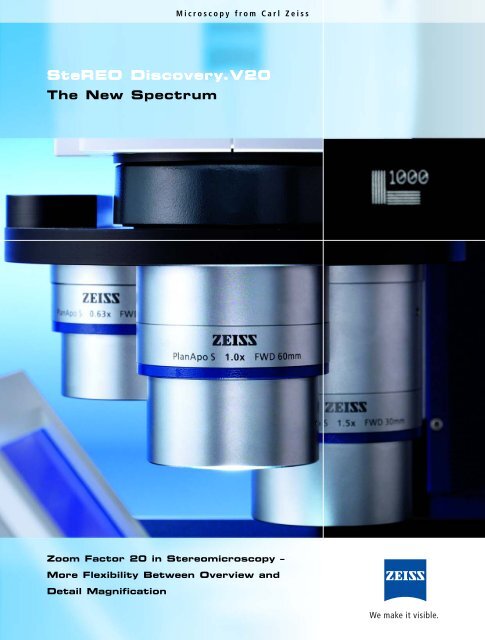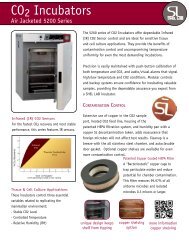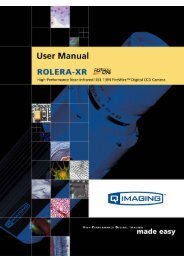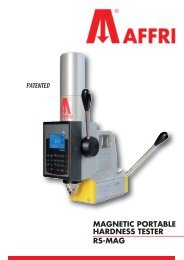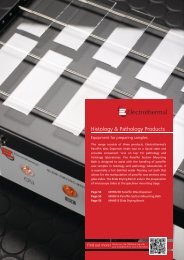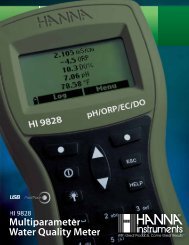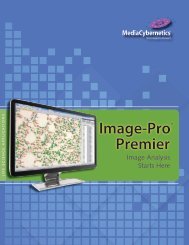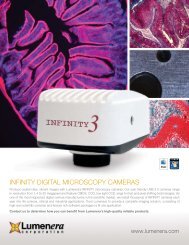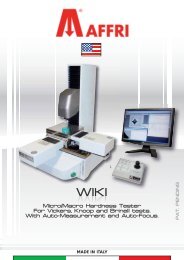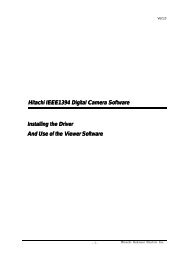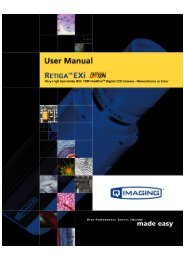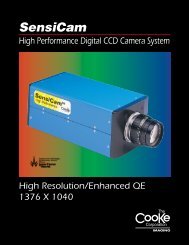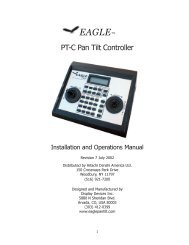SteREO Discovery.V20 SteREO Discovery.V20 - Carl Zeiss ...
SteREO Discovery.V20 SteREO Discovery.V20 - Carl Zeiss ...
SteREO Discovery.V20 SteREO Discovery.V20 - Carl Zeiss ...
Create successful ePaper yourself
Turn your PDF publications into a flip-book with our unique Google optimized e-Paper software.
SFact Innovation:Never Before hasthe MagnificationSpectrum beenLarger.There’s a new performance standard in the demandingworld of stereomicroscopy: Zoom Factor 20. The factorfor the largest spectrum between overview and detailmagnification. The microscope: <strong>SteREO</strong> <strong>Discovery</strong>.<strong>V20</strong>.A <strong>Carl</strong> <strong>Zeiss</strong> design. And a research instrument withwhich the pioneer of the CMO principle (Common MainObjective) has once again broken new ground for thefuture of stereomicroscopy after the telescope principle.The development of the <strong>SteREO</strong> <strong>Discovery</strong>.<strong>V20</strong> hasexceeded the limits of conventional modes of action.Founded on a new technological base and integratedinto the <strong>SteREO</strong>* generation series from <strong>Carl</strong> <strong>Zeiss</strong>,<strong>SteREO</strong> <strong>Discovery</strong>.<strong>V20</strong> is highly impressive and boastsa superior performance profile. For maximum precisionand considerably more freedom in biology, medical andindustrial labs. The new features:• planapochromatic corrected microscope bodieswith a zoom range of 20:1• high end magnification of up to 345x(with eyepiece 10x)• maximum resolution of 1000LP/mm(with objective PlanApo S 2.3x)• excellent 3D-effect up to the highestmagnification• comfortable, securely reproducible operationaland control concept with SyCoP• seamless integration into the modular systemof the <strong>SteREO</strong> <strong>Discovery</strong> generation* <strong>SteREO</strong> – Stereomicroscopy Redefined in Ergonomics and Optics2
teREO <strong>Discovery</strong>.<strong>V20</strong>3
The Performance Factor:Superiority Can be DocumentedAt the borders of technical possibilities detailsbecome a critical factor. Better optics is responsiblefor a visible improvement in image information. Theeasier operation concept delivers faster results. Factorswhich <strong>Carl</strong> <strong>Zeiss</strong> places the utmost importance onin development and consistently optimizes until thepeak of performance is reached. The results createnew benchmarks. At any place where living objectsor material samples are observed, manipulated ordocumented in detail, three-dimensionally and withhigh resolution or high contrast.1.SyCoP1A in 3D: Spatial impressionWith <strong>SteREO</strong> <strong>Discovery</strong>.<strong>V20</strong>, higher magnificationscan also be realized with smaller lenses thanks tothe large zoom range of the microscope body. Thesmaller stereo angles associated improve the 3Dimpression of the microscopic image. The result:you remain more relaxed during observation andnotice even the smallest details.2.Secure the highestmagnifications: StabilityHigh image resolution and end magnification placenew demands on the stability of the stand system ofthis stereomicroscope. All relevant components weredesigned and built according to the most modernmethods. The stands feature a significantly higherrigidity and is considerably less susceptible to vibrationsthan previous systems. The motor focusing makes finefocusing in intervals of 350 nm in a range of 340 mmfor loads of up to 17 kg possible.3.1. With SyCoP, even the most complex stereomicroscopic operationprocedures can be handled comfortably. Without letting thesample out of your sight. With one hand, reliable and flawless.42. The new <strong>SteREO</strong> <strong>Discovery</strong>.V12 zoom body is parfocally adjusted.For pin sharp pictures in the complete magnification range.3. Extraordinarily large working area:the stand design with decentralized profile column S.
Intelligent operation: SyCoPSyCoP stands for System Control Panel and for aconsiderable gain in time, overview capability andflexibility in the operation of increasingly complexoperation procedures. Designed especially for thedemands of stereomicroscopy, the novel operationconcept combines joystick, keys and touch screen inthe handy design of a computer mouse. With SyCoP,almost all important microscope functions can becontrolled virtually location-independent. Fast, preciseand reproducible. Without removing your eyefrom the eyepiece ocular. Your attention stays onthe object. In addition, SyCoP provides current dataabout the total magnification, object field, resolutionand depth of focus of your microscope setting.SyCoP is an option for the future. New functionsand further accessories are integrated through theopen CAN-Bus concept.Increase free space:Zoom factor 20:1The largest range from overview to detail –<strong>SteREO</strong> <strong>Discovery</strong>.<strong>V20</strong> has brought a new zoomrange into the research laboratory. And what’smore: even the basic configuration of this top stereomicroscopeoffers an end magnification of 150x.Equipped with the nosepiece S. cod as well asthe objectives PlanApo S 0.63x, PlanApo 1x andPlanApo S 2.3x, <strong>SteREO</strong> <strong>Discovery</strong>.<strong>V20</strong> covers amagnification range from 4.7 to 345x. That is afactor of 73! With only one turn of the nosepiece.Decide economically:The <strong>SteREO</strong> <strong>Discovery</strong>upgrade concept<strong>SteREO</strong> <strong>Discovery</strong> offers a wide spectrum of compatiblemodules and accessory components. Nomatter what instrument type you choose, you havethe freedom to upgrade your system according toyour needs at any time. Up to the highest-capacityImaging System that stereomicroscopy has to offercurrently.Sophisticated and universally compatible:the wide accessory range fits for everyinstrument type of the <strong>SteREO</strong> <strong>Discovery</strong>generation.5
<strong>SteREO</strong> <strong>Discovery</strong>.The Technology Factor:Exceeding the LimitsBetter 3D images, higher resolution, larger zoomranges – technologically, the conventional stereomicroscopehas reached its limits. Each lens, eachmechanical detail exhibits tolerances – regardless ofthe precision of the production. The higher thedemands on resolution and magnification become,the less acceptable are these tolerances.The solution:The new active principleOn the <strong>SteREO</strong> <strong>Discovery</strong>.<strong>V20</strong>, this mechanical curvehas been replaced by a virtual one. The movablelenses are moved with a stepping motor and positionedexactly with a processor. The microscopicimages then stay considerably sharper. That has somedefinite advantages for your research applications:At the limits:The conventional technologyThe centerpiece of a CMO stereomicroscope is thepancrat (microscope or zoom body). During zooming,lenses are moved and must be brought into acertain position in relation to other securely installedlenses with extraordinary precision. Untilnow a mechanical curve – a simple metal piecemilled with great care – determined largely parts theexactness of the traverse path of these lenses andthereby the overall microscope quality. The precisionrequired for new stereomicroscope generations canno longer be fulfilled in this way.• 3D images can be viewed in the stereomicroscopein a noticeably more relaxed wayThe partial images which are produced for oureyes are much sharper and better coordinated.The effort of the brain to create a 3D imageis less.• Sharper images producecontrast improvementsParticularly decisive when the stereomicroscopeis used in high and the highest magnifications.Microscopy pushed to the limits of usefulmagnification.• Higher magnifications with alarger zoom rangeUntil recently a zoom with a factor of 16 butnot higher was considered technically possiblebut this limit can now be exceeded considerablywith this new technology. And it’s affordable.<strong>Carl</strong> <strong>Zeiss</strong> has created a new milestone in stereomicroscopywith the <strong>SteREO</strong> <strong>Discovery</strong>.<strong>V20</strong>. Over 30invention disclosures and patent applications are providingthat this technological advantage is preserved.6Fast, flexible and effective: the final assembly of the stereomicroscope<strong>SteREO</strong> <strong>Discovery</strong> in the clean rooms of <strong>Carl</strong> <strong>Zeiss</strong> Microscopy GmbHin Jena. It is customized as “individual item chain production according tothe Wertstrom design criteria”.
<strong>V20</strong>1.1. Before the assembly begins each lens is exactly calibratedagainst a “0-lens type”. This lens value is digitally saved ina data pool – the basis on which computer-calculatedcombinations are established. By doing this, an optimallycoordinated lens family is developed for every individualmicroscope2. Rotating reflexes of a lens. As soon as it is in the circle…2.3. ... a moveable micro clapper of the computer-controlledglue leveling machine autonomously undertakes the finealignment.4. After being moved into place, the lenses are immediatelyfixed. Precision tools automatically lay high-precision,uninterrupted glue beads through a strong cannula0.5 mm wide.5. Hardening of the glue beads under UV-radiation.6. In the pancrat adjusting device, the precise procedures of allmoveable optical elements are programmed. To do this,around 7000 supporting points are analyzed via computer.In doing so, each stereomicroscope obtains its own correction– its own individual zoom control curve.3.4.Depth of field curve, with in these parameters the picture isin focusTypical defocus curve of one channel with classical adjustment(pancrat with mechanical zoom curve)Typical defocus curve of one channel of the <strong>SteREO</strong> <strong>Discovery</strong>.<strong>V20</strong>(pancrat with virtual electronically derived curve)Defocus position in µmZoom position ofpancrat5.Illustration of the defocus curve of a classical mechanical pancrat in comparisonto a motorized one (<strong>SteREO</strong> <strong>Discovery</strong>.<strong>V20</strong>). It is clear that the motorized pancratdiffers from the 0 line about half less than the mechanical one. That means:<strong>SteREO</strong> <strong>Discovery</strong>.<strong>V20</strong> with motorized pancrat delivers twice as sharp images.6.7
SThe Flexibility Factor:the Upgrade Possiblities are EndlessThe modular construction of the <strong>SteREO</strong> <strong>Discovery</strong>.<strong>V20</strong>is typical for main lens stereomicroscopes. The multitudeof accessory components which you can haveinstalled on the high-capacity stereomicroscope inorder to create an effective observation and documentationsystem is correspondingly wide . The flexibilityis unusual: completely integrated into the<strong>Carl</strong> <strong>Zeiss</strong> system world and equipped with intelligentinterfaces, each component can be installed for everyinstrument type in the <strong>SteREO</strong> <strong>Discovery</strong> range.1. TubesToday ergonomics is a basic demand on microscopy.The user’s posture should remain relaxed even overlong periods of work. An important factor for thisare the observation tubes. The eyepiece sockets areswingable and adjustable in two levels. With theergotube the angle of vision can be individuallyadjusted between 5 and 45 degrees.2. ObjectivesObjectives largely determine the image quality –and they are a relevant economic factor. The selectionof objectives for the <strong>SteREO</strong> <strong>Discovery</strong>.<strong>V20</strong>receives special attention for a reason. The spectrumranges from the cost-effective objectives of theAchromat series to the high-capacity Plan-Achromatobjectives to the Plan-Apochromat series, whichmeets the highest requirements.3. StagesDesigned to move your objects gently and jolt-freeduring observation – a wide spectrum of differentstages is available for the <strong>SteREO</strong> <strong>Discovery</strong>.<strong>V20</strong>.According to your needs, choose from sliding,rotating, mechanical or ball-and-socket stages.The motorized mechanical stage offers an additionaladvantage in precision when adjusting andcontrolling objects: precisely accurate, fast andreproducible.4. FluorescencePentaFluar S is the retrofittable intermediate tubewith a coaxial fluorescence mechanism which convertsyour <strong>SteREO</strong> <strong>Discovery</strong>.<strong>V20</strong> into a highcapacityfluorescence system. The filter turretholds up to five filter modules and there are alsomany possibilities regarding illumination. Besidesthe well-established HBO lamps, X-Cite 120 witha liquid lightguide is recommended.1. 2. 3.4.8
teREO <strong>Discovery</strong>.<strong>V20</strong>5. CamerasThe demands on the documentation of microscopicimages in research are as different as the projectsthemselves. The spectrum of digital microscopecameras for the innovative high-performancesystem <strong>SteREO</strong> <strong>Discovery</strong>.<strong>V20</strong> is correspondinglydiverse. Starting with digital consumer camerasthrough to professional cameras of the microscopecamera family AxioCam, <strong>Carl</strong> <strong>Zeiss</strong> offers you a suitableprice and performance class for every demand.8.and securely operable. This is the foundation of thefact that the control of the current highest-capacitystereomicroscopy research device practically runsitself.6. IlluminationThe quality of illumination essentially determinesthe quality of the results – in particular with stereomicroscopiccontrasts. With an elaborate system ofinterfaces and adapters, <strong>SteREO</strong> <strong>Discovery</strong>.<strong>V20</strong> canbe equipped with modern fiber optic LED-components.Optimal for the illumination and contrastingof various objects.7. OperationCompletely motorized, <strong>SteREO</strong> <strong>Discovery</strong>.<strong>V20</strong> offersreproducibility and considerable simplifications foryour experiment procedures. In particular for controllingobject details as well as for setting illuminationand contrasts. In addition, the innovative controlsystem is now available. Designed to be user-friendly8. Microscope SoftwareAxioVision is the superior software for microscopecontrol, image acquisition, image processing,image administration and archiving. With a universalmodular design and upgradeable according toyour needs from the basic version to the mostdemanding special configuration. The microscopesoftware from <strong>Carl</strong> <strong>Zeiss</strong> is completely integrated tothe current highest-capacity analysis platform andholds a top position worldwide on account of itssimple operation principle and its high productivity.5. 6.9
SPractical Life Sciences:High Magnifications,Excellent Depth PerceptionTrue to reality, completely shift-free 3D imaging ofthe researched specimen are the demands ofcontemporary stereomicroscopy. From a completeoverview down to the smallest detail like organs,tissues and neurons. Now, <strong>Carl</strong> <strong>Zeiss</strong> raises the bareven higher.1.<strong>SteREO</strong> <strong>Discovery</strong>.<strong>V20</strong> with its zoom of 20x doesn’tjust deliver a large magnification range, it also shineswith a brilliant image quality in the research of livingspecimen and other objects of Life Science. The consequentminimization of stray light of all tubes, thezoom body and the objectives as well as the individuallytailored zoom curve, allow for a rich contrastin the images over the entire zoom range – from theoverview up to the highest magnification. The largebase and the grand front lens add to the unique3D effect.2.Therefore the <strong>SteREO</strong> <strong>Discovery</strong>.<strong>V20</strong> ensures animage quality that you can count on in researchfacilities and laboratories of biology and medicine. Itis also ideal to observe and research model organismsof developmental biology.3.1. Mouse embryo, stained, transmitted-light brightfield,objective PlanApo S 0.63x, magnification 4.7x*2. Mouse embryo, stained, transmitted-light brightfield,objective PlanApo S 0.63x, magnification 94x*3. Diatome, transmitted-light darkfield,objective PlanApo S 2.3x, magnification 345x*10
teREO <strong>Discovery</strong>.<strong>V20</strong>Practical Materials:99% Reproducibility,100% Investment SecurityThe demands for high-end stereomicroscopes risewith the perception of smaller details. On one handthere is the need for fast orientation of where youare in the specimen and that requires a largeoverview. On the other hand there is the need forobserving and documenting the smallest detail ina rapid switch from the overview image – ideallywithout re-focussing.1.The <strong>SteREO</strong> <strong>Discovery</strong>.<strong>V20</strong> with a zoom of 20x givesyou a vast advantage in your lab. It is the onlystereomicroscope that allows a fast switch fromoverview to detail image. Here the motorised zoomdelivers a precise and free to choose zoom position.And it only differs less than 1%. That means areproducibility of more than 99%! This is the precisionof an ideal research instrument with itsalways correctly scaled images to measure anddocument tasks in micromechanics and qualitycontrol. And it is a safe investment into a newdimension of achievement.2.3.1. Semiconductor, reflected-light darkfield,objective PlanApo S 1x, magnification 7.5x*2. Semiconductor, reflected-light darkfield,objective PlanApo S 1x, magnification 150x*3. Semiconductor, reflected-light darkfield,objective PlanApo S 1x, magnification 20x*,Extended Depth of Focus* Total magnification through eyepieces11
<strong>SteREO</strong> <strong>Discovery</strong>.<strong>V20</strong>:The Technical DataObjectivesEyepiecesDescriptionFactorFWD(mm)WPL 10x/23 Br. foc PL 16x/16 Br. foc W 25x/10 focMagnification Object Field (mm) Magnification Object Field (mm) Magnification Object Field (mm)PlanApo S0.63x 81PlanApo S1.0x 60PlanApo S1.5x 30PlanApo S2.3x 10PlanApo S3.5x mono 16Plan S1.0x 81Achromat S0.3x 253Achromat S0.5x 151Achromat S0.63x 115Achromat S1.0x 69Achromat S1.5x 284.7x … 94.5x 48.7 … 2.4 7.6x … 151x 33.9 … 1.7 11.8x … 236x 21.1 … 1.17.5x … 150x 30.7 … 1.5 12x … 240x 21.3 … 1.1 18.8x … 375x 13.3 … 0.711.3x … 225x 20.4 … 1.0 18x … 360x 14.2 … 0.7 28.1x … 563x 8.9 … 0.417.3x … 345x 13.3 … 0.7 27.6x … 552x 9.3 … 0.5 43.1x … 863x 5.8 … 0.326.3x … 525x 8.8 … 0.4 42x … 840x 5.5 … 0.27 65.6x … 1312.5x 3.5 … 0.187.5x … 150x 30.7 … 1.5 12x … 240x 21.3 … 1.1 18.8x … 375x 13.3 … 0.72.3x … 45x 102 … 5.1 3.6x … 72x 71.1 … 3.6 5.6x … 113x 44.4 … 2.23.8x … 75x 61.3 … 3.1 6x … 120x 42.7 … 2.1 9.4x … 188x 26.7 … 1.34.7x … 94.5x 48.7 … 2.4 7.6x … 151x 33.9 … 1.7 11.8x … 236x 21.1 … 1.17.5x … 150x 30.7 … 1.5 12x … 240x 21.3 … 1.1 18.8x … 375x 13.3 … 0.711.3x … 225x 20.4 … 1.0 18x … 360x 14.2 … 0.7 28.1x … 563x 8.9 … 0.4430<strong>Carl</strong> <strong>Zeiss</strong> Microscopy GmbH07745 Jena, Germanymicroscopy@zeiss.comwww.zeiss.de/stereo-discoveryPrinted on environmentallyfriendlypaper, bleached withoutthe use of chlorine.Subject to change.46-0128 e 05.2007


